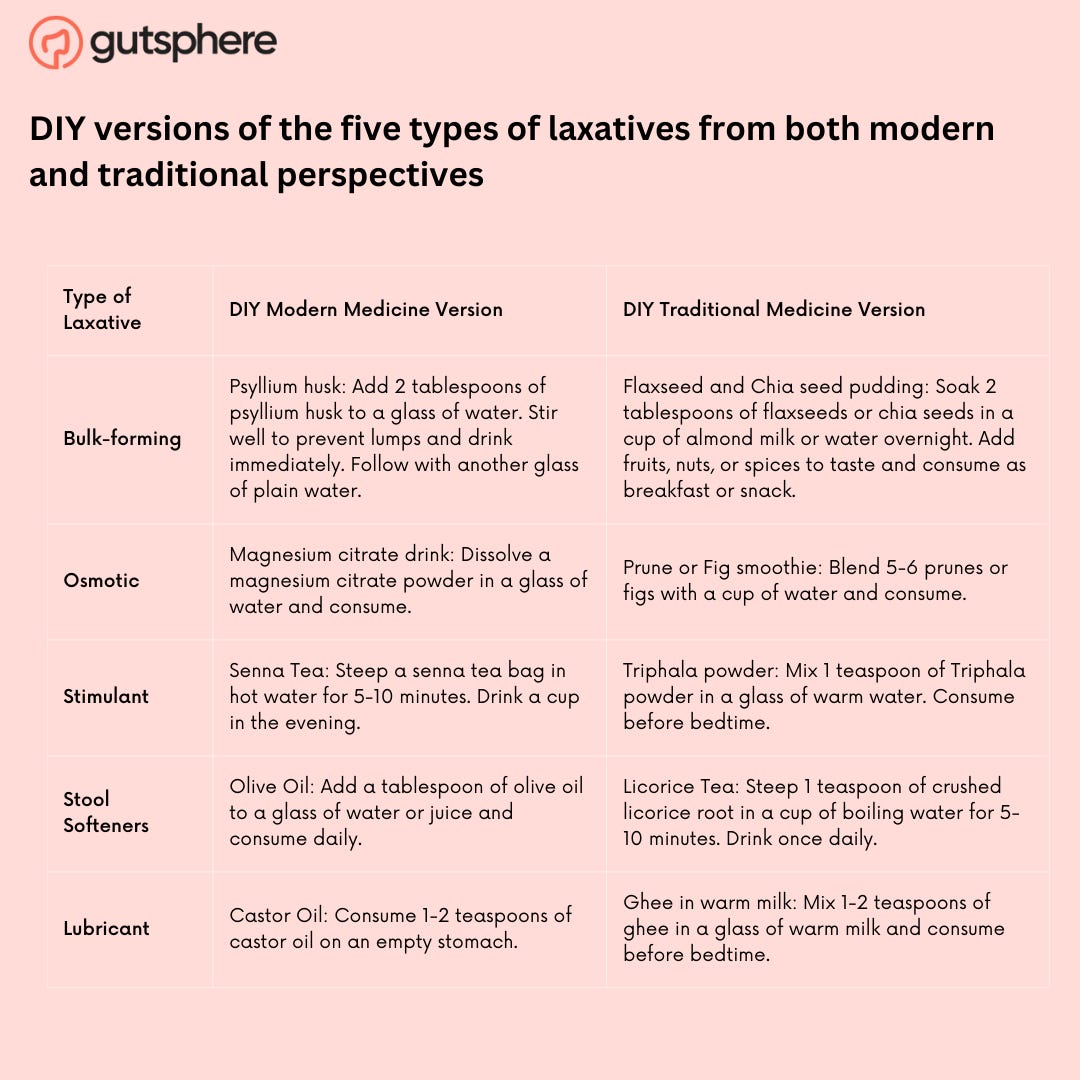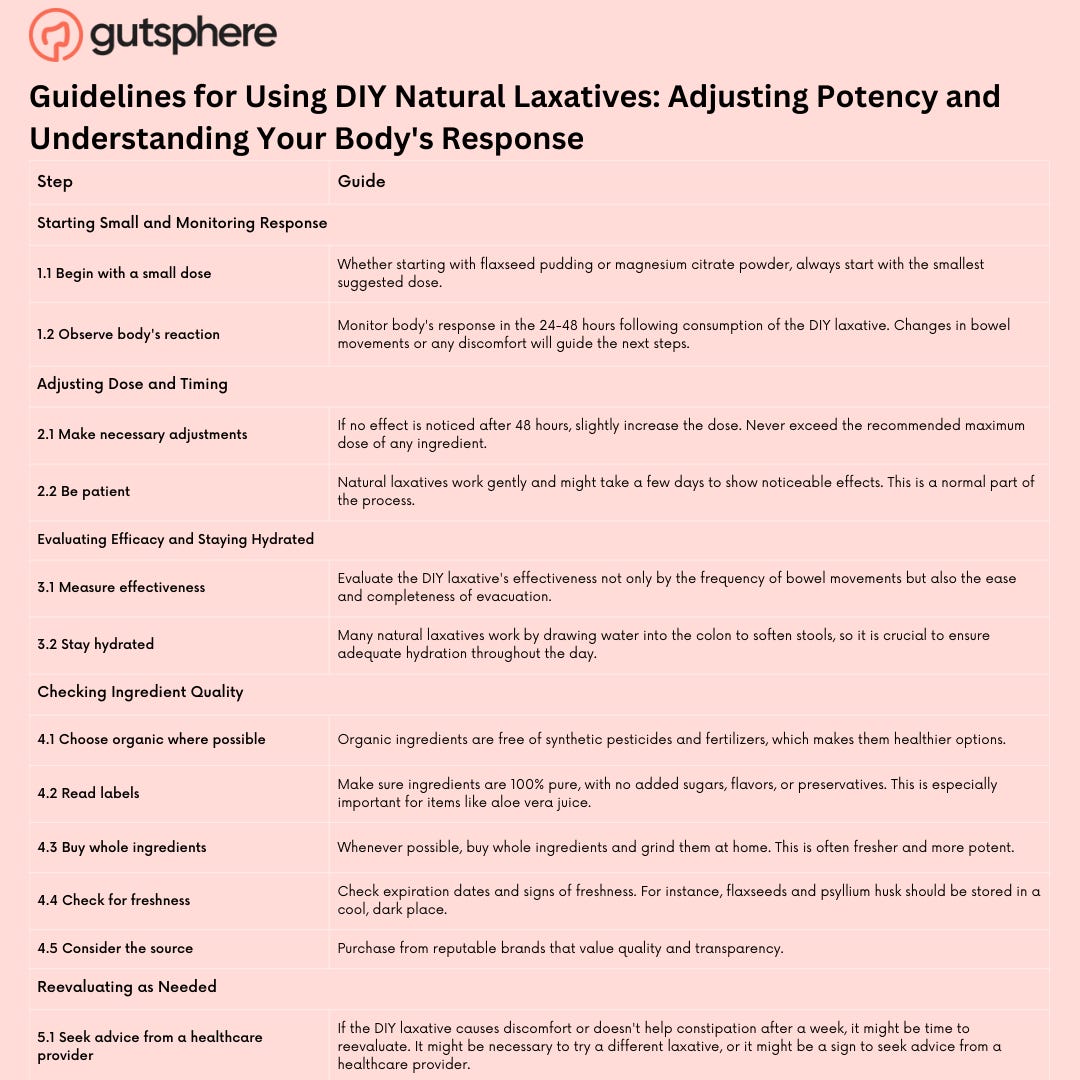Nature’s Laxatives: DIY Alternatives for a Healthy Gut ( Part 4/5)
Embrace Natural and Homemade Laxatives: Understanding Their Efficacy and Learning How to Prepare Them
Welcome Back GutSphere Friends,
After delving into the intricacies of laxatives, their impact on various aspects of our health, and the potential risks and benefits, we are ready to step into the realm of nature's own laxatives. In this section, we'll explore the wonders of natural alternatives, homemade solutions, and simple lifestyle changes that can help us maintain a healthy gut without the need for over-the-counter laxatives. We will uncover the power of diet and exercise, understand the role of prebiotics and probiotics, and even learn how to create our own natural laxatives at home.
A tabular summary of Part 4: Nature’s Laxatives: DIY Alternatives for a Healthy Gut.
This summary provides an at-a-glance overview of the key points in Part 4 of our series on laxatives and gut health. Remember to use this as a guide and not a substitute for professional medical advice.
Sources:
Suares, N. C., & Ford, A. C. (2011). Prevalence of, and Risk Factors for, Chronic Idiopathic Constipation in the Community: Systematic Review and Meta-analysis. The American Journal of Gastroenterology, 106(9), 1582–1591. https://pubmed.ncbi.nlm.nih.gov/21606976/
Lembo, A., & Camilleri, M. (2003). Chronic constipation. New England Journal of Medicine, 349(14), 1360-1368.https://pubmed.ncbi.nlm.nih.gov/14523145/
Attaluri, A., Donahoe, R., Valestin, J., Brown, K., & Rao, S. S. C. (2011). Randomised clinical trial: dried plums (prunes) vs. psyllium for constipation. Alimentary pharmacology & therapeutics, 33(7), 822-828. https://pubmed.ncbi.nlm.nih.gov/21323688/
Chung, B. D., Parekh, U., & Sellin, J. H. (1999). Effect of Increased Fluid Intake on Stool Output in Normal Healthy Volunteers. https://pubmed.ncbi.nlm.nih.gov/9916661/
Pereira, M. A.. Dietary Fiber and Body-Weight Regulation. Observations and Mechanisms. https://pubmed.ncbi.nlm.nih.gov/11494646/
Effects of Aerobic Exercise and Mind-Body Exercise in Parkinson’s Disease: A Mixed-Treatment Comparison Analysis, https://www.ncbi.nlm.nih.gov/pmc/articles/PMC8637737/
Rome Foundation. (2016). Rome IV Diagnostic Criteria for Functional Gastrointestinal Disorders. https://theromefoundation.org/rome-iv/rome-iv-criteria/
Introduction to Natural Alternatives for Different Types of Laxatives
In our journey to seek solutions for constipation, we often overlook the power of nature, a bounty that offers us many alternatives for laxatives. Just like pharmaceutical laxatives, natural alternatives can be classified into several categories based on how they work: bulk-forming, osmotic, and stimulant.
Bulk-forming alternatives are rich in dietary fiber and include foods like psyllium husk, flax seeds, and whole grains. They add bulk to the stool and help it pass through the gut more easily.
Osmotic natural alternatives, such as prunes, figs, and magnesium-rich foods, help draw water into the gut to soften the stool and facilitate its passage.
Stimulant alternatives, like senna and cascara, work by stimulating the muscles of the gut to increase bowel movement. While these are natural, it's important to use them sparingly as overuse can lead to dependency.
Are Natural Alternatives to Laxatives Just as Effective?
The effectiveness of natural alternatives to laxatives can be highly individual and largely depends on the underlying cause of constipation. For many of us, natural alternatives can work just as well as over-the-counter laxatives. However, it's important to keep in mind that they often work more slowly, requiring a bit more patience.
For instance, bulk-forming alternatives may take a few days to a week to produce noticeable effects. Osmotic and stimulant alternatives usually work more quickly, but regular use over a prolonged period should be avoided to prevent dependency.
While these natural alternatives can be highly effective, it's always a good idea to consult a healthcare provider if constipation persists or if there are other worrying symptoms.
Can Dietary Changes Have Similar Effects to Laxatives?
Absolutely! The power of dietary changes should not be underestimated when it comes to maintaining gut health. Our diet is one of the key drivers of gut motility, and tweaking it can yield significant improvements in constipation.
High-fiber foods act much like bulk-forming laxatives, adding bulk to the stool and facilitating its passage. Incorporating more fruits, vegetables, whole grains, and legumes into our diet can greatly help regulate bowel movements.
Additionally, certain foods naturally contain substances that act like osmotic or stimulant laxatives. Prunes, for example, are rich in sorbitol, a natural osmotic laxative. They also contain a compound called diphenyl isatin, which stimulates bowel movement.
Dietary Changes for Better Digestive Health
In our quest for better digestive health, the first line of action is often dietary changes. A diet rich in fiber is crucial for smooth and regular bowel movements. The American Dietetic Association recommends a daily intake of 25 grams of fiber for women and 38 grams for men. This can be achieved by consuming a variety of fiber-rich foods such as fruits, vegetables, legumes, and whole grains.
Staying well-hydrated is another key aspect of digestive health. Water helps soften the stool and facilitates its passage through the gut. It's recommended to drink at least 8 glasses of water per day, but this may vary depending on individual needs and lifestyle factors.
Incorporating probiotic-rich foods like yogurt, kefir, and fermented vegetables can also support a healthy gut microbiome, which plays a critical role in digestion and overall gut health.
Avoiding or limiting intake of processed foods, which are often low in fiber and high in fat, can also be beneficial for preventing constipation.
Can Lifestyle Modifications Replace the Need for Laxatives?
In many cases, lifestyle modifications can indeed reduce or even eliminate the need for laxatives. While dietary changes are a crucial aspect of this, there are several other modifications that can also be beneficial.
Regular physical activity, for instance, can help stimulate gut motility and promote regular bowel movements. It doesn't have to be vigorous exercise - even light activities like walking can be helpful.
Establishing a regular bowel routine can also be beneficial. Setting aside a specific time each day for bowel movements, preferably after a meal, can help train the gut to become more regular.
Additionally, managing stress through techniques like yoga, mindfulness, and meditation can also play a role in improving gut health. Chronic stress has been linked to a variety of digestive issues, including constipation.
Finally, it's important to listen to our body's signals. Ignoring the urge to have a bowel movement can lead to constipation. Thus, responding promptly to these signals can help maintain regular bowel movements.
Are There Specific Exercises That Can Help Alleviate Constipation?
Exercise is a natural stimulant for the digestive system. It helps to keep food moving through the digestive system and can reduce the time it takes for the stool to pass, which helps keep the stool soft and easier to pass. While any exercise can be beneficial, certain types of physical activity are particularly effective for promoting bowel movements.
Walking, for instance, is a great way to stimulate bowel movements due to its gentle, low-impact nature. It can easily be incorporated into our daily routine and does not require any special equipment.
Yoga is another excellent option. Certain yoga poses, like the wind-relieving pose (Pavanamuktasana), the seated forward bend (Paschimottanasana), and the triangle pose (Trikonasana), can help stimulate the digestive system and relieve constipation.
Aerobic exercises, such as jogging, swimming, or cycling, can also help increase heart rate and stimulate gut motility.
Physical Activity and Hydration: The Natural Antidotes to Constipation
Physical activity and hydration go hand in hand as natural antidotes to constipation. Physical activity stimulates the muscles in the gut, promoting regular bowel movements. Hydration, on the other hand, helps keep the stool soft and easy to pass.
It's recommended to get at least 30 minutes of moderate-intensity physical activity most days of the week. This can include activities like brisk walking, cycling, swimming, or even gardening.
As for hydration, a common rule of thumb is to aim for at least 8 glasses of water per day. However, individual hydration needs can vary depending on factors like age, sex, weight, physical activity levels, and climate. It's important to listen to our body and drink when we're thirsty. Also, keep in mind that all fluids count towards our hydration, not just water. Other beverages like herbal tea and fruit juice, as well as water-rich foods like fruits and vegetables, can also contribute to our hydration.
Herbs and Supplements that Support Digestive Health
In addition to dietary and lifestyle changes, certain herbs and supplements can also support digestive health.
Ginger, for example, is a traditional remedy for various digestive complaints, including constipation. It's thought to help stimulate digestion and speed up the movement of food through the gut.
Peppermint has also been used for centuries to soothe digestive issues. It may help relax the muscles of the gut, relieving symptoms of constipation.
Flaxseeds are rich in dietary fiber and can act as a natural laxative. They can be easily incorporated into our diet by adding them to things like smoothies, oatmeal, or yogurt.
Magnesium supplements can also be effective in relieving constipation. They work by drawing water into the gut, softening the stool, and promoting its passage.
However, while these herbs and supplements can be beneficial, it's always a good idea to consult a healthcare provider before starting any new supplement regimen.
Introduction to DIY Natural Laxatives: Safety and Effectiveness
Many of us may not realize it, but our kitchen pantry holds a treasure trove of natural laxatives. These DIY solutions can be a safe and effective way to manage constipation. However, just like any remedy, it's important to use them responsibly and in moderation.
Are There Any Safety Concerns With Using Natural or DIY Laxatives?
While natural and DIY laxatives can be a safe alternative to over-the-counter laxatives, they're not without potential risks. Overuse can lead to dependency, causing the bowel muscles to become lazy and less effective at moving stool on their own.
In addition, even natural substances can cause adverse effects if used in excess. For instance, overconsumption of fiber can lead to bloating and gas, while excessive intake of magnesium can cause diarrhea.
Always remember that while natural, these remedies are still medicines and should be used with caution. Start with a small dose to see how your body reacts and adjust as needed. If constipation persists or is accompanied by other worrying symptoms, it's best to seek medical advice.
Preparing Your Own Bulk-Forming Laxatives
Preparing your own bulk-forming laxatives is as simple as incorporating more fiber-rich foods into your diet. Flaxseeds, chia seeds, and psyllium husk are all excellent choices.
You can make a simple flaxseed or chia seed pudding by soaking the seeds in water or a plant-based milk overnight. This creates a gel-like consistency that not only acts as a bulk-forming laxative but is also delicious and versatile. You can add your favorite fruits, nuts, or spices to make it more enjoyable.
Psyllium husk can be mixed with water or added to smoothies, oatmeal, or yogurt. Remember to drink plenty of water when consuming these fiber-rich foods to help the fiber work more effectively.
Preparing Your Own Osmotic and Stimulant Laxatives
Making your own osmotic and stimulant laxatives can also be quite simple.
For an osmotic laxative, you can make a simple magnesium citrate drink by dissolving a magnesium citrate powder in water. Alternatively, you can prepare a natural fruit juice laxative by blending prunes or figs with water.
As for stimulant laxatives, you can brew a cup of senna tea or aloe vera juice. These should be used sparingly as they can lead to dependency when used regularly over a prolonged period.
Here's a table summarizing DIY versions of the five types of laxatives from both modern and traditional perspectives:
These DIY alternatives can serve as a general guide and are considered relatively safe, but it's always best to consult with a healthcare provider before making any significant changes to your health regimen, especially if you have any existing medical conditions or are taking other medications. Also, long-term use of laxatives, even natural or DIY ones, can potentially lead to dependency or disrupt the natural function of your digestive system, so it's best to use them only when necessary and focus on more permanent dietary and lifestyle changes for long-term gut health.
Guidelines for Using DIY Natural Laxatives: Adjusting Potency and Understanding Your Body's Response
When using DIY natural laxatives, it's important to start with a small dose and slowly increase if needed. This allows us to understand our body's response and adjust the potency accordingly. Below is an actionable guide.
Starting Small and Monitoring Response:
Begin with a small dose: No matter which DIY natural laxative we're starting with, it's best to begin with a small dose. For instance, if we're making a flaxseed pudding, we start with just 1 tablespoon of flaxseeds. If we're using magnesium citrate powder, we begin with the smallest suggested dose on the packaging.
Observe our body's reaction: We need to pay attention to how our bodies respond in the 24-48 hours following consumption of the DIY laxative. Do we notice a difference in our bowel movements? Are we experiencing any discomfort, bloating, or gas? Our body's responses will guide our next steps.
Adjusting Dose and Timing:
Make necessary adjustments: If we notice no effect after 48 hours, we can slightly increase the dose of our DIY laxative. For example, increase from 1 tablespoon to 2 tablespoons of flaxseeds in our pudding, or slightly increase the magnesium citrate powder dose. However, we should never exceed the recommended maximum dose of any ingredient.
Be patient: Natural laxatives work gently and might take a few days to show noticeable effects. This is normal and a part of the process.
Evaluating Efficacy and Staying Hydrated:
Measure effectiveness: Understanding whether the DIY laxative is working for us is not only about the frequency of bowel movements, but also the ease and completeness of evacuation. If we feel relieved and lighter after bowel movements, it's a good sign that the laxative is working for us.
Stay hydrated: Many natural laxatives work by drawing water into the colon to soften stools, making hydration crucial. We should ensure we're drinking plenty of water throughout the day.
Checking Ingredient Quality:
Choose organic where possible: Organic ingredients are grown without the use of synthetic pesticides and fertilizers, which is not only better for the environment, but also ensures that we're not ingesting any of these harmful substances.
Read labels: Ensure the ingredients we purchase are 100% pure, without any added sugars, flavors, or preservatives. This is especially important for items like aloe vera juice, which can sometimes contain added ingredients.
Buy whole ingredients: Where possible, we should buy whole ingredients and grind them ourselves. For example, buying whole flaxseeds and grinding them at home is often fresher and more potent than buying pre-ground flaxseeds.
Check for freshness: We need to check the expiration date on all products before purchasing. Also, look for signs of freshness in ingredients. For instance, flaxseeds and psyllium husk should be stored in a cool, dark place to maintain their potency.
Consider the source: We should purchase from reputable brands or sources that value quality and transparency. For herbs and supplements, consider the brand's testing practices, quality assurance measures, and sourcing policies.
Reevaluating as Needed:
If our DIY laxative is causing discomfort or not helping our constipation after a week, it might be time to reevaluate. We may need to try a different DIY laxative, or it might be a sign that we should seek advice from a healthcare provider.
Remember, it's normal for bowel habits to vary a bit from day to day. Occasional constipation doesn't necessarily mean we need to use a laxative. But if we're regularly experiencing discomfort or straining with bowel movements, these DIY options can be a part of our toolkit while we also work on long-term dietary and lifestyle changes to support our gut health. As always, seek medical advice if constipation persists or is accompanied by other worrying symptoms.
Conclusion:
In our journey to understand laxatives, we've explored both the commercially available options and nature's own remedies. We've learned that maintaining a healthy gut can be as simple as incorporating certain foods into our diet, staying hydrated, and exercising regularly. Natural alternatives, while requiring a little more effort and patience, can be just as effective as conventional laxatives, and often with fewer potential side effects. However, it's important to remember that what works best will always depend on our individual health conditions, preferences, and lifestyles. In the next and final installment of this series, we will discuss how to reduce dependency on laxatives and strengthen our gut health, diving deeper into the science of gut motility, the impact of stress and mental health on bowel movements, and more.
Next Part 5: Redefining Gut Health: Minimizing Laxative Dependency
Next time, we will move beyond treating the symptoms of constipation and delve into redefining our gut health. We'll explore holistic approaches to digestive wellness, including mind-body practices, the power of prebiotics and probiotics, and the role of mental health in gut function. Are you ready to take charge of your gut health? Stay tuned!
Request
Share
Our sincere request to you is to share the newsletter with your friends, family, and community so that they can benefit from the content. Also it will help us grow the newsletter, and eventually, as we release more content, digital tools, and more we will enable people around the world to live chronic disease free.
Subscribe
If you haven’t already subscribed then our sincere request, please subscribe.
Feedback
Also, please give us feedback so that we can improve the content. And if there are any topics that you want us to cover please send us your questions and topics. Furthermore, if you try any of the things we provided information please share your experience with us.
Thank You
gutsphere Team
Disclaimer
Please note that the information provided in this newsletter is for informational purposes only and should not be considered as a substitute for professional medical advice, diagnosis, or treatment. If you have any concerns or questions about our health, please consult with a licensed healthcare professional. The information contained in this newsletter is not intended to diagnose, treat, cure, or prevent any disease. The publisher and authors of this newsletter assume no responsibility for any adverse effects that may result from the use of the information contained herein.





